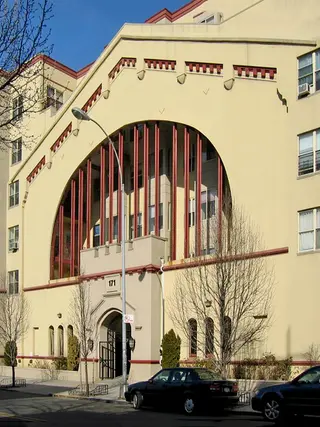 Carter Horsley
Carter HorsleyDec 23, 2011
Carter's Review
This 6-story building at 171 Clermont Avenue in the Fort Greene section of Brooklyn is known as Clermont Armory Towers and is on the site of a former armory.
It is also known as 156-172 Vanderbilt Avenue.
It has 110 rental apartments.
Robert M. Scarano Jr. was the architect for its conversion to residential uses in 2000.
It opened in August, 2000 with two wings behind the façade of the original armory overlooking an elevated courtyard with three of the wrought-iron curved trusses that spanned the original drill hall that was built in 1873.
Ten of the apartments on the Clermont Avenue side have spacious balconies facing a front atrium created behind the original façade.
The building has 24-hour concierge and doorman service, a laundry room, video surveillance and attended parking.
The project was financed by the "New Housing Opportunities" program of the New York City Housing Development Corporation that is targeted to middle-income families or individuals.
Funding for the Clermont Avenue Armory to house the 23rd Regiment of the National Guard, a veteran unit of the Battle of Gettysburg, was appropriated in 1871 in the amount of $160,000. It was designed by William R. Mundell in the French Second Empire Style and completed in 1873.
The most notable feature of the building was its 130-by180-foot drill hall, which was then the largest hall without pillars or obstructions in the United States. According to the building's website, the hall's "wrought iron balloon shed was among the earliest in America (possibly second only to that at the original Grand Central Terminal dating from 1869-71) and may be the oldest surviving example of this type of construction in the country.
In 1911, the building was extensively reconstructed an architect Floyd Peterson designed a new façade on Clermont Avenue in a neo-Medieval style that typifies armory design of the early 20th century. The sandstone base of the original building was retained and the alterations did not impact the drill hall.
The building was in continuous use as an armory until it was transferred to the city in 1964. The city used it as a warehouse until 1986 when it was vacated due to deteriorated conditions and lack off maintenance. In December, 1989, vandals, operating at night and with a truck, began stripping the building of salvageable material including all the oak paneling from the commander's room, fireplace mantles and "historic" fabric as well as all copper waterproofing, gutters and drains.
In 1995, the current owners acquired the property at auction and the New York State Office of Historic Preservation ruled that it did not qualify for listing in the National Register of Historic Places and therefore did not qualify for historic preservation tax benefits.

- No Fee Rental built in 1873
- Converted in 2000
- Located in Clinton Hill
- 110 total apartments 110 total apartments
- Doorman
 6sqft delivers the latest on real estate, architecture, and design, straight from New York City.
6sqft delivers the latest on real estate, architecture, and design, straight from New York City.
